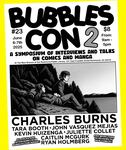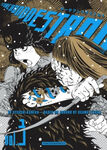
<<• edited by Chris Polkki •>> Don't let the fact that some of your favorite comics anthologies are concluding their runs get you down: there's a world of comics out there waiting to be discovered. Take this swell 100-page anthology from 2005, for example. We thought it was long gone, but we stumbled on a source and so are eager to let late-comers in on this swell package of comics from around the world, with a special emphasis on the Japanese avant garde. Bête Noire features what we believe was the first North American publication of Yuichi Yokoyama, as well as works by fellow Japanese manga masters Junko Mizuno, Ichiba Daisuke, Takeshi Nemoto and Suzy Amakane. Also on hand are Helge Reumann of Switzerland, Anke Feuchtenberger of Germany, Ludovic Debeurme, Lucie Durbiano and Caroline Sury of France, as well as artists from Italy, Spain, Finland, along with Kevin Scalzo, Renée French and cover artist David Heatley from the USA. Recommended for readers of Kramers Ergot, MOME and Blood Orange (which Mr. Polkki also edited).

Robel and Reumann, known collectively as Elvis Studio, have with Elvis Road produced a true one-of-a-kind item: a 9" x 264" (that's 22 feet!) comic book panel in which everything happens at once. When the entirety of the "story" is laid out in a single image and the mind has to pick and choose on its own, the reader can't help but recognize that the process of creating a story out of an assemblage of visual information is transformed. While, at least in theory, the entire spectacle as presented to the reader is intended to be seen as occurring in a single instant, the reader will almost certainly find him or herself processing the image into some form of narrative as it is simply impossible to achieve a simultaneous apprehension of the image's entirety the way one can and does when reading the intellectually bite-size pieces presented in standard comics. Elvis Road enables -- one might even go so far as to say forces -- the reader to invent a new approach to reading the image, as the methods developed to read a standard comic book will be insufficient here. The temporal dimension necessarily becomes opened to the reader, who can and must move forward and backward, left and right, up and down through the image, in the process assigning a temporal order. This in turn will allow the reader an opportunity to examine and reevaluate just how the distinct order and layouts of panels that constitute standard comic book language represent a digestion of visual experience, and to ponder that it may very well be just this compartmentalization of experience into discrete units that forms our sense of time as a narrative. In other words, Elvis Road is a meta-narrative in comics. It achieves, through the authors' choice of presenting an entire "saga" in a single image, an auto-critique of standard comics' narrative forms. In addition, it harkens back to the tapestry, which is, arguably, one of the tributary streams that served as a source for the mighty river of comics; and by doing so hints at further, overlooked possibilities for comics in the future.
Elvis Road is now out of print, but we still have a few copies available. LIMIT: one per customer.










